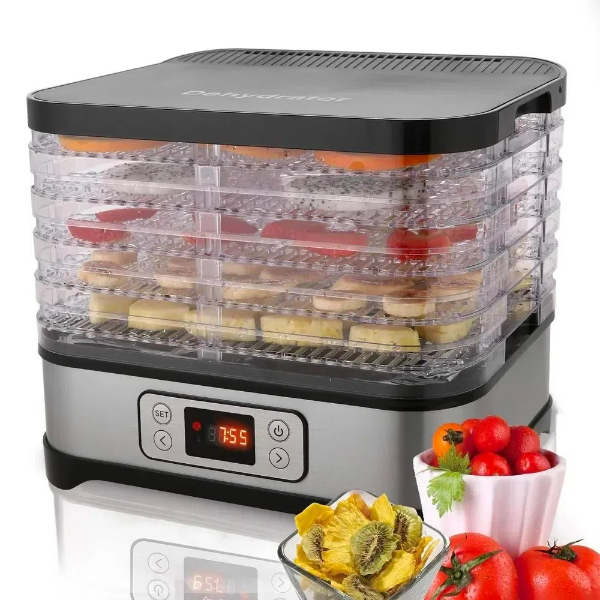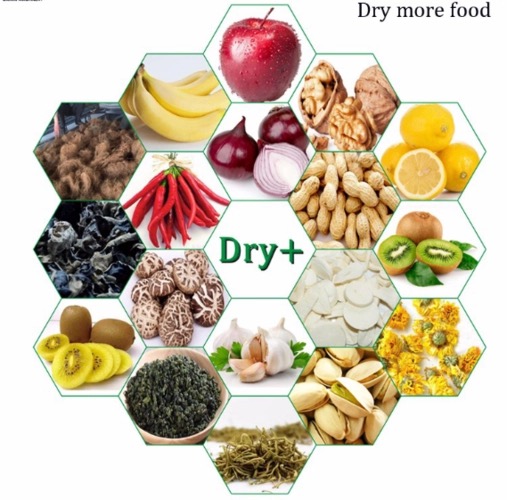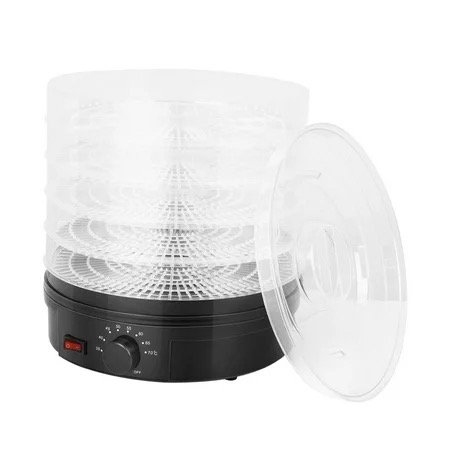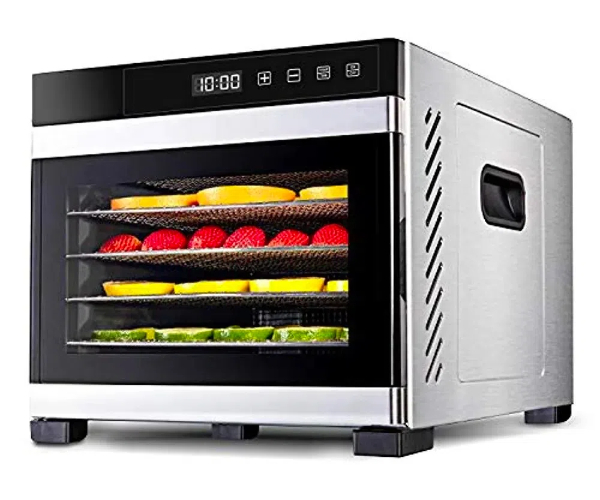
Content Menu
● Introduction to Fruit Dryer Machines
● Understanding the Basics of Food Dehydration
● The Benefits of Using a Fruit and Vegetable Dryer
● Choosing the Right Fruit Dryer Machine
>> Capacity
>> Temperature Control
>> Airflow and Fan
>> Noise Level
>> Energy Efficiency
● Popular Types of Fruit Dryer Machines
>> Stackable Tray Dehydrators
>> Shelf Dehydrators
>> Commercial Food Dehydrators
● How to Use Your Fruit Dryer Machine Effectively
● Creative Uses for Your Fruit Dryer Machine
● Maintaining Your Fruit Dryer Machine
● The Environmental Impact of Using a Fruit Dryer Machine
● Comparing Fruit Dryer Machines to Other Preservation Methods
>> Freezing
>> Canning
>> Dehydrating
● Conclusion: Embracing the Versatility of Fruit Dryer Machines
● Frequently Asked Questions
>> 1. How long does it take to dry fruits in a food dehydrator?
>> 2. Can I use a fruit dryer machine to make beef jerky?
>> 3. How do I clean my fruit dryer machine?
>> 4. Are dried fruits as nutritious as fresh fruits?
>> 5. Can I use my fruit dryer machine to dehydrate vegetables and herbs?
Introduction to Fruit Dryer Machines
In today's fast-paced world, where convenience and health-conscious choices often intersect, fruit dryer machines have emerged as a popular kitchen appliance. These versatile devices, also known as food dehydrators, offer a simple yet effective way to preserve fruits, vegetables, and even meats, allowing us to enjoy nature's bounty year-round. Whether you're a health enthusiast, a gardener with excess produce, or simply someone looking to reduce food waste, a fruit dryer machine can be an invaluable addition to your kitchen arsenal.
Understanding the Basics of Food Dehydration
Food dehydration is an ancient preservation technique that has stood the test of time. The process involves removing moisture from food items, which inhibits the growth of bacteria, yeasts, and molds. This simple yet effective method not only extends the shelf life of foods but also concentrates their flavors, making dried fruits and vegetables a delicious and nutritious snack option.
Modern fruit dryer machines have revolutionized this age-old practice, making it accessible and efficient for home use. These electric food dehydrators use a combination of low heat and air circulation to gently remove moisture from foods, preserving their nutritional value and natural flavors.
The Benefits of Using a Fruit and Vegetable Dryer
Investing in a fruit and vegetable dryer offers numerous advantages for both your health and your wallet:
1. Preservation of Nutrients: Unlike some preservation methods that can degrade nutritional content, dehydration retains most of the vitamins and minerals present in fresh produce.
2. Cost-Effective: By dehydrating seasonal fruits and vegetables when they're abundant and affordable, you can enjoy your favorite produce year-round without breaking the bank.
3. Reduced Food Waste: A fruit dryer machine allows you to preserve excess produce that might otherwise spoil, significantly reducing food waste in your household.
4. Convenience: Dried fruits and vegetables are lightweight, compact, and easy to store, making them perfect for on-the-go snacking or as ingredients in various recipes.
5. Customization: With a home food dehydrator, you have complete control over the ingredients, allowing you to avoid additives and preservatives often found in store-bought dried foods.

Choosing the Right Fruit Dryer Machine
When selecting a fruit dryer machine, several factors come into play. Here are some key considerations to help you make an informed decision:
Capacity
Consider how much food you plan to dehydrate at once. Multi-tray food dryers offer greater capacity and flexibility, allowing you to dry different types of foods simultaneously. For occasional use or smaller households, a compact model with fewer trays might suffice. However, if you have a large garden or plan to dehydrate foods in bulk, a larger capacity machine would be more suitable.
Temperature Control
Different foods require different drying temperatures for optimal results. Look for a fruit dryer machine with adjustable temperature settings, typically ranging from 95°F to 165°F (35°C to 74°C). This feature allows you to precisely control the drying process for various types of produce and even meats for making jerky.
Airflow and Fan
Efficient air circulation is crucial for even drying. Look for models with powerful fans and well-designed airflow systems to ensure consistent results across all trays.
Noise Level
Some fruit dryer machines can be noisy due to their fans. If you're sensitive to sound or plan to run the dehydrator overnight, consider models known for quiet operation.
Energy Efficiency
Since dehydrating foods can take several hours, an energy-efficient food dryer can help keep your electricity bills in check. Look for models with energy-saving features or those certified for low energy consumption.
Popular Types of Fruit Dryer Machines
Stackable Tray Dehydrators
These are the most common type of home food dehydrators. They consist of a base unit with a heating element and fan, and multiple trays that stack on top. Stackable models are often expandable, allowing you to add more trays as needed.
Shelf Dehydrators
These units resemble mini ovens with removable shelves. They often offer more consistent drying results due to their enclosed design but may have a larger footprint than stackable models.
Commercial Food Dehydrators
For those looking to dehydrate large quantities of food, commercial-grade dehydrators offer increased capacity and durability. These machines are ideal for small businesses or avid gardeners with abundant harvests.

How to Use Your Fruit Dryer Machine Effectively
To get the most out of your fruit and vegetable dryer, follow these tips:
1. Prepare foods properly: Wash and dry all produce thoroughly. Slice fruits and vegetables uniformly to ensure even drying.
2. Pretreat when necessary: Some fruits, like apples and bananas, benefit from pretreatment with lemon juice or ascorbic acid to prevent browning.
3. Arrange foods in a single layer: Avoid overcrowding the trays to allow for proper air circulation.
4. Rotate trays: If your model doesn't have a rotating feature, manually rotate the trays periodically for even drying.
5. Check for doneness: Dried fruits should be pliable but not sticky, while vegetables should be crisp or brittle.
6. Store properly: Once cooled, store dried foods in airtight containers in a cool, dark place to maintain freshness.
Creative Uses for Your Fruit Dryer Machine
While dried fruits and vegetables are the most common products of a food dehydrator, these versatile machines can be used for much more:
1. Homemade Jerky: Create your own flavored beef, turkey, or even vegetarian jerky for a protein-packed snack.
2. Dried Herbs: Preserve fresh herbs from your garden for use throughout the year.
3. Fruit Leathers: Make all-natural fruit rolls for a healthy alternative to store-bought fruit snacks.
4. Dried Flowers: Preserve flowers for crafts or potpourri.
5. Pet Treats: Create healthy, preservative-free treats for your furry friends.
6. Yogurt: Some dehydrators can be used to make homemade yogurt.
7. Bread Proofing: The low, consistent heat of a dehydrator can create an ideal environment for proofing bread dough.
Maintaining Your Fruit Dryer Machine
Proper maintenance of your fruit and vegetable dryer will ensure its longevity and optimal performance:
1. Clean trays and the interior after each use with warm, soapy water.
2. Check and clean the air filters regularly if your model has them.
3. Inspect the fan and heating element periodically for dust buildup and clean gently with a soft brush or cloth.
4. Store the dehydrator in a clean, dry place when not in use.
5. Follow the manufacturer's instructions for any specific maintenance requirements.
The Environmental Impact of Using a Fruit Dryer Machine
In an era of increasing environmental consciousness, it's worth considering the eco-friendly aspects of using a fruit dryer machine:
1. Reduced Food Waste: By preserving foods that might otherwise spoil, you're contributing to the reduction of food waste, a significant environmental issue.
2. Lower Carbon Footprint: Dried foods are lighter and require less energy to transport compared to their fresh counterparts, potentially reducing transportation-related emissions.
3. Seasonal Eating: Dehydrating seasonal produce allows you to enjoy local, seasonal foods year-round, reducing the need for out-of-season imports.
4. Packaging Reduction: By creating your own dried snacks, you can significantly reduce the amount of packaging waste associated with store-bought alternatives.
Comparing Fruit Dryer Machines to Other Preservation Methods
While fruit dryer machines offer numerous benefits, it's helpful to understand how they compare to other food preservation methods:
Freezing
Pros: Retains most nutrients, preserves texture well for many foods.Cons: Requires constant electricity, limited by freezer space, can alter texture of some foods.
Canning
Pros: Long shelf life, preserves large quantities efficiently.Cons: Can be time-consuming, requires specific equipment and knowledge, some nutrient loss due to high heat.
Dehydrating
Pros: Concentrates flavors, lightweight results, long shelf life without refrigeration, retains most nutrients.Cons: Texture changes, initial time investment, some foods may lose color.
Conclusion: Embracing the Versatility of Fruit Dryer Machines
Fruit dryer machines offer a world of possibilities for food preservation and healthy snacking. From creating your own dried fruit snacks to experimenting with homemade jerky and beyond, these versatile appliances can transform the way you approach food storage and consumption. By understanding the benefits, choosing the right model, and mastering the techniques of food dehydration, you can unlock a new level of culinary creativity while reducing food waste and enjoying nutritious snacks year-round.
Whether you're a health-conscious individual, a busy parent looking for wholesome snack options, or an avid gardener seeking ways to preserve your harvest, a fruit and vegetable dryer can be an invaluable tool in your kitchen. As we continue to seek sustainable and health-focused solutions in our daily lives, the humble fruit dryer machine stands out as a simple yet effective way to make the most of nature's bounty.

Frequently Asked Questions
1. How long does it take to dry fruits in a food dehydrator?
Answer: The drying time for fruits can vary depending on the type of fruit, its water content, and the thickness of the slices. On average, most fruits take between 6 to 16 hours to dry completely. Berries and thinly sliced apples might dry in as little as 6-8 hours, while denser fruits like pineapples or pears can take up to 12-16 hours. It's important to check your fruits periodically and adjust the drying time as needed to achieve the desired texture.
2. Can I use a fruit dryer machine to make beef jerky?
Answer: Yes, most fruit dryer machines are versatile enough to make beef jerky. In fact, many food dehydrators come with specific settings or instructions for making jerky. When making beef jerky, it's crucial to use a dehydrator that can reach and maintain a temperature of at least 165°F (74°C) to ensure food safety. Always follow proper food handling guidelines and recipes specifically designed for making jerky in a dehydrator to ensure a safe and delicious result.
3. How do I clean my fruit dryer machine?
Answer: Cleaning your fruit dryer machine is relatively simple:
1. Unplug the machine and allow it to cool completely.
2. Remove all trays and wash them with warm, soapy water. Rinse and dry thoroughly.
3. Wipe down the interior of the dehydrator with a damp cloth. For stubborn residues, use a soft sponge with mild detergent.
4. Clean the exterior with a damp cloth.
5. If your model has removable filters, clean or replace them according to the manufacturer's instructions.
6. Ensure all parts are completely dry before reassembling and storing the dehydrator.
4. Are dried fruits as nutritious as fresh fruits?
Answer: Dried fruits retain most of the nutrients found in fresh fruits, with some variations. The dehydration process concentrates the fruits' natural sugars and calories, making dried fruits more calorie-dense than their fresh counterparts. While some heat-sensitive vitamins like vitamin C may decrease slightly during the drying process, other nutrients become more concentrated. Dried fruits are excellent sources of fiber, vitamins, minerals, and antioxidants. However, it's important to consume them in moderation due to their higher calorie content.
5. Can I use my fruit dryer machine to dehydrate vegetables and herbs?
Answer: Absolutely! Fruit dryer machines are designed to dehydrate a wide variety of foods, including vegetables and herbs. Vegetables like carrots, bell peppers, onions, and zucchini dehydrate well and can be used in soups, stews, or as healthy snacks. Herbs such as basil, oregano, thyme, and parsley can be dried to preserve their flavors for use throughout the year. When drying vegetables and herbs, be sure to follow specific guidelines for each type, as drying times and temperatures may vary from those used for fruits.












